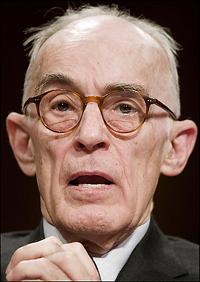Clark Hoyt, the public editor, or ombudsman, of the New York Times, went after Edward Luttwak in his weekly column today for the military historian’s controversial May 12 op-ed on why Sen. Obama would be considered an “apostate†by many Muslims and thus particularly susceptible to assassination attempts if, as president, he were to go on a state visit to a Muslim nation. After consulting with five Islamic scholars at U.S. universities on whether Luttwak’s argument was consistent with Islamic law, Hoyt concluded that Luttwak’s assertions were essentially baseless and “extreme†and strongly implied that the op-ed should not have been published at all. (The headline of Hoyt’s essay was “Entitled to Their Opinions, Yes. But Their Facts?â€) Hoyt also took to task the op-ed editor, David Shipley, for publishing only letters to the editor in response to the original op-ed and not providing space for a full rebuttal.
This is not the first time that Luttwak, who has long gloried in his role as an unconventional policy provocateur (usually, but not always, on behalf of hawkish, if not neo-conservative, forces in Washington), has written attention-grabbing op-eds that are based on no factual evidence of any kind. I haven’t compiled them in any systematic way, but one example some 20 years ago really stands out as a warning to all op-ed editors at elite newspapers that Luttwak was not the most careful of researchers.
On November 22, 1987, Luttwak published an op-ed in the Washington Post entitled “A Member of Moscow’s Exclusive Club†which argued that the fact that then-Nicaraguan President Daniel Ortega was seated next to East German leader Erich Honecker and Polish President Gen. Wojciech Jaruzelski “in the section reserved for the leaders of Leninist governments in good standing†at the opening of the Communist Party Congress in Moscow conveyed a “very definite message: the Sandinista regime has been admitted to the very exclusive club of governments that the Soviet Union regards as permanent, organic allies.†[emphasis in original] The conclusion:
“If there were any suspicion that the Sandinistas might actually allow the democratization required by the Arias peace plan, creating the possibility of a peaceful change of government by free elections, Ortega would not have been seated where he was.â€
Within the op-ed space, the Post reprinted the AP photo cropped in a way that only Ortega’s face was visible.
There was only one problem with both the photo and Luttwak’s analysis (aside from the fact that the Sandinistas did indeed accede to a peaceful change of government by free elections under the Arias plan): Ortega was not seated next to Honecker and Jaruzelski. What Luttwak had thought was one photo of the three leaders seated together that had appeared in the Times and other newspapers on November 3 was actually two distinct photos separated by a thin white line: one of Honecker and Jaruzelski seated next to each other, the other of Ortega and a man whom the Times later identified as Gus Hall. In fact, the latter two were seated in an entirely different section of the hall, as was indicated by the entirely different angles of Ortega’s face (presumably fixed on Gorbachev at the podium) and those of Honecker and Jaruzelski.
Luttwak, in other words, had based his entire analysis (and he was very close to senior Reagan administration officials, such as then-Undersecretary for Policy Fred Ikle and Assistant Secretary of State for Inter-American Affairs Elliott Abrams) at the time –that the Soviet Union now considered Nicaragua as as integral a part of its empire as Poland and East Germany — on a total visual misapprehension.
“Am I the only person who has seen the photographs published in all our newspapers,†he asked. “Americans are still furiously debating the nature of the Sandinista regime in Nicaragua and its intent in regard to the Arias peace plan, but surely that question has been settled conclusively by the photos that appeared on Nov. 3, the day after the opening of the Party Congress in Moscow.â€
Despite several letters to the editor (including one from me sent the day of the op-ed’s publication) pointing out the obvious error, the Post never issued a correction or an explanation. (After all, in order to crop Ortega’s photo to incorporate it into Luttwak’s op-ed, the newspaper’s editors should have known that the factual premise on which his analysis was based was completely faulty.) So It fell to a Post columnist, the late and great Phil Geyelin, to write his own op-ed in rebuttal one week after Luttwak’s article came out. In reply to Luttwak’s question whether he was the only person who had seen the “telltale photographs,†Geyelin wrote:
“No, Edward, you are not the only one; but you may be the only one who failed to notice that the photographic display in The New York Times actually consisted of two photographs, one of Honecker and Jaruzelski seated side by side, and another of Ortega alone. There was white space between the two shots and nothing in the caption to suggest that the three men were even in the same room.
“Nor was there, according to authorities I’ve talked to, a special section ‘reserved’ for ‘Leninist governments.’ True, the communist countries of Eastern Europe were lumped together. But Ortega was no closer to them than he was to a mixed gaggle of Socialist leaders, including representatives of India’s ruling National Congress, the Italian Communist Party, and the PLO’s Yasser Arafat. So much for the ‘political precision’ of Soviet seating arrangements or the claim that â€the nature†of the Sandinistas, or their intentions, has been ’settled conclusively.’
So, the next time you see an analysis by Edward Luttwak, be sure to scrutinize the factual premises very carefully. That goes especially for editors and talk-show producers.
 Visit Lobelog.com for the latest news analysis and commentary from Inter Press News Service’s Washington bureau chief Jim Lobe.
Visit Lobelog.com for the latest news analysis and commentary from Inter Press News Service’s Washington bureau chief Jim Lobe.





 The sad news just reached us that
The sad news just reached us that  Another big victory for Michelle Malkin over the forces of terrorism!
Another big victory for Michelle Malkin over the forces of terrorism! In the ad, Ray wears a scarf around her neck and holds an iced coffee. Malkin, complained that the scarf looked similar to the black-and-white checkered kaffiyeh, the traditional Palestinian scarf. Malkin explained:
In the ad, Ray wears a scarf around her neck and holds an iced coffee. Malkin, complained that the scarf looked similar to the black-and-white checkered kaffiyeh, the traditional Palestinian scarf. Malkin explained: